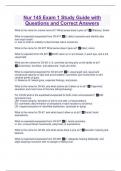Nur 145 Exam 1 Study Guide with
Questions and Correct Answers
What is the name for cranial nerve #1? What sense does it give us? ✅Olfactory; Smell.
What is expected/unexpected from CN #1? ✅E- able to perceive and identify odor
from each nostril.
U- loss of smell or inability to discriminate odors (anosmia).
What is the name for CN #2? What sense does it give us? ✅Optic; vision.
What is expected from CN #2? ✅20/20 vision w/ or w/o lenses, in each eye, and a full
visual field.
What are the names for CN #3, 4, 6, and what do they give us the ability to do?
✅Oculomotor, trochlear, and abducnes; "eyes do tricks".
What is expected/unexpected for CN #3,4,6? ✅E- equal pupil size, equal and
consensual reponse to light and accomodation, symmetric eye movements in all 6
cardinal points of gaze.
U- Absence of: lateral gaze, expected findings, and ptosis.
What is the name for CN #5, and what actions do it allow us to do? ✅Trigeminal;
sensation and motor tone of the face (biting/chewing).
For CN #5 what is the expected/unexpected for both motor and sensation? ✅EM-
symmetric tone.
UM- muscle atrophy, deviation of jaw to one side, or fasciculations.
ES- symmetric discrimination of sensations in each location to all stimuli.
US- impaird sensation w/ identified distribution. (evaluate w/ temp)
What is the name for CN #7, and what does it allow us to do? ✅Facial; facial
expressions.
What is expected/unexpected from CN #7? ✅E- facial symmetry.
U- tics, unusual facial movements, assymetry of expressions.
What is the name for CN #8, and what sense does it give us? ✅Acoustic; hearing and
balance.
What is expected/unexpected from CN #8? ✅E- adequate hearing bilaterally, and
slight swaying movemen with no danger of falling over.
, U- non aqequate hearing bilaterally, and staggering, losing balance, swaying to the
extent of falling.
What device is used for a hearing screening test? What test is used to check balance?
✅Audiometer; Romberg test.
What is the name for CN #9, and what 2 things is it responsible for?
✅Glossopharyngeal; taste and gag reflex.
Why is it so important to check for a gag reflex before adminstering anything PO? ✅No
gag reflex = aspiration.
What is the name for CN #10? What does it control? ✅Vagus; motor function (inside
mouth), assists #9 w/ gag reflex, swallowing, and speech.
For CN #10 what is expected/unexpected regarding all 4 functions. ✅EM- soft palate
rises with uvula in midline.
UM- Failure of soft palate to rise, or uvula deviates from midline.
EG- upward movement of palate and contraction of pharynegeal muscles, w/ uvula in
midline.
UG- drooping or absence of arch on either side of soft palate; uvula deviates from
midline.
ES- water easily swallowed.
US- retrograde passing of water through nose.
USP- hoarseness, nasal quality, or difficulty guttural sounds.
What happens when the vagus nerve is stimulate? ✅Bradycardia
What is the name for CN #11, and what muscles does it control? ✅Spinal accessory
nerve; trapezius and sternocleidomastoid muscles.
What is expected for CN #11? ✅E- symmetric size, shape, and strength.
What is the name for CN #12, and what does it control? ✅Hypoglossal; the tounge.
For CN #12 what is expected/unexpected for the tounge at rest and movement? ✅ER-
tounge is midline, symmetric size.
UR- fasciculations assymetry, atrophy, or deviation from midline.
EM- able to perform most tounge movements.
What 3 things make up the peripheral nervouse system? ✅Spinal nerves, cranial
nerves, and the autonomic nervous system.
What does the autonomic nervous system control and maintain? ✅Controls most
tissue function (blinking, breathing), and maintains homestasis.




